|
Index...
|
 n a Sunday morning at about 9:30 a.m., dressed in our Sunday best, my Dad, Brother and I were on our way to the bus stop to go to town to see our Gran at Back 13, Canterbury Street, in Hillfields. We had walked from our house past the grounded balloon on the common and were at the bus stop in front of the Shepherd & Shepherdess for a 16 or 16A bus, whichever came first, being the weekend service. It was a bright day with white thickish foggy type cloud and the sun trying to break through. No sirens had sounded, nor did they ever on that Sunday. Dad was holding our hands and talking to three other waiting men. Suddenly, and seemingly from behind us, towards the Co-Op on the Scotchill / Keresley Green Road corner came the sound of a fast approaching low flying aircraft, out of sight all the time. The sound seemed suddenly to turn hard toward us over the pond at the end of the common, now the traffic circle.
n a Sunday morning at about 9:30 a.m., dressed in our Sunday best, my Dad, Brother and I were on our way to the bus stop to go to town to see our Gran at Back 13, Canterbury Street, in Hillfields. We had walked from our house past the grounded balloon on the common and were at the bus stop in front of the Shepherd & Shepherdess for a 16 or 16A bus, whichever came first, being the weekend service. It was a bright day with white thickish foggy type cloud and the sun trying to break through. No sirens had sounded, nor did they ever on that Sunday. Dad was holding our hands and talking to three other waiting men. Suddenly, and seemingly from behind us, towards the Co-Op on the Scotchill / Keresley Green Road corner came the sound of a fast approaching low flying aircraft, out of sight all the time. The sound seemed suddenly to turn hard toward us over the pond at the end of the common, now the traffic circle.
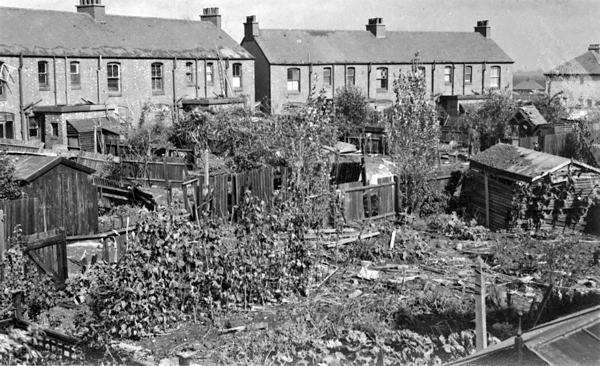
All the time out of sight, but the engine's roar was passing slightly to our front overhead. As I looked towards the sound to try to see the hidden aircraft it suddenly started firing the first of several bursts of its guns, which we could hear as he flew off down towards Radford and the city. Dad ran, my Brother in one hand, me on the other, and dived behind the Shep's boundary wall - far too late, but just in case he went round and came back. Needless to say we went back home and Mum was surprised to see us back and said she'd heard a scraping sound she thought was the newspaper boy dragging his clipboard on the rough casting outside the kitchen door, and went to pay him. We heard later that a car was shot up in Radford. There was no siren alert and the balloons were sent up only after the event. A piece of advice Dad gave to me was that if something ever happens like that again, to jump behind the nearest garden wall until it was safe to move. Advice that I completely forgot in a blind panic when I was where I was not supposed to be a very short time later during our school midday lunchtime on yet another eventful day!
With the erratic nightly raids and general uncertainty we rarely knew whether the bombs had landed far or near in the darkness - they were just explosions in this or that direction. With a lack of sleep it was not unusual to stay at home for a few hours to get some sleep if a parent considered it had been a rough night - or some were sent away until things settled down. All sorts of reasons at that difficult time. On this day I went to school, and a young friend of mine who'd been missing for a few days came back to school and said his home had been caught by blast and the roof at the back of his house was badly damaged, and I went home with him during our 12-2 p.m. lunch time. He lived on The Scotchill, between Morton Crescent and Sadler Road. By the time we got there around twelve thirty and were looking at the damage upstairs to the open roof and ceilings, the sirens suddenly sounded and my panic to get home started. I immediately ran out into The Scotchill and started to run back towards the common. The sirens were still wailing - the sound now intermingled with another sound - of aircraft engines behind me. As I ran, suddenly the bombs exploding adding fear to my panic. I think I was trying to get to my Aunt's house near to the Fire Station, and was about halfway between Fraser and Addison Roads, terrified and in tears.
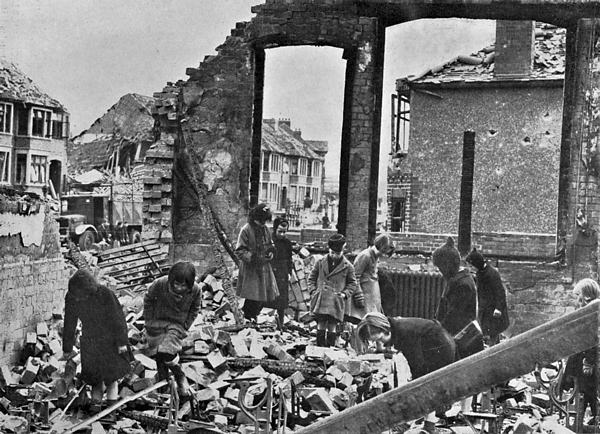
The road was now empty, only me, and behind me was the sounds of aircraft and exploding bombs. Suddenly an ARP Warden appeared in front of me yelling to get to a shelter. I turned and ran back toward Frazer Road and saw for the first time the circling planes flying from my right to left, bombing in front of me. Just as I turned up Frazer Road I ran into two more Wardens, and one screamed that he would "take his belt off to me". I was "wall-eyed with fright" and ran back down and turned to the left, back past my friends house where it all started, now running straight towards the Dunlop and seeing the grey planes going round and round as I ran turning left up into Sadler Road.
By now I started to think, and remembered Dad's advice to jump over a garden wall, which I did, and lay between it and a privet hedge in a front garden, and waited listening to the changing droning of the planes. It now dawned on me that despite the explosions there was no shrapnel or windows breaking behind me, and seemingly no danger to me, so I cautiously peeped over the wall and watched the last few minutes as the grey bombers circled, swooped and climbed, dropping their remaining bombs. Then they all formed into a group and flew off into the sky between Dunlop and Foleshill Gasometer, gradually fading from my sight in the haze.
With the sound of the engines' increasing and decreasing revs now gone, the only sounds were various cracklings and bangings coming from the smoking, burning Dunlop, which I could plainly hear from where I watched awestruck from my position several hundred yards away. The high water storage tank with the word DUNLOP painted in large letters toward my side, the odd letters or full word DUNLOP now appearing on and off through the swirls of smoke, billowing black smoke. As I watched, a tiny flash like a far off mirror caught my eye to my right, and it grew larger, and then I realised it was a plane flying straight towards me - the Perspex nose reflecting in the afternoon sun as it came in from, I would imagine, the Brinklow direction. It then suddenly started a right turn towards the Dunlop, but nearer towards me, and as it turned its wing came up on my side - the duck egg blue under-belly showing the black crosses on the wings. Then it levelled out and became grey, the black tail swastika and fuselage cross showing clearly as he flew just above the tank, clear of the smoke on my side, as he released his 2 x 2 bombs so casually as if in a fly-past. Then it turned climbing, flying off in the same direction as the rest to the south-east. In hindsight I imagine the latecomer came to survey the damage, as he flew so much closer to me than those in the attack. I cannot see in my mind's eye as much Perspex on them, so maybe they were Ju-88s, which accounts for it.
The lone late visitor was definitely an HE111 because of the Perspex up front, but I cannot be sure that the original circling bombers had the same all-glass fronts, or how many planes there were, but think at least eight or ten. I was still far too awestruck by what was happening in front of me, the "follow my leader" flying, level from my right to left, keeping an equal distance between each plane and the next, flying into the area immediately after the previous bombs exploded, then dropping his own, the next plane doing the same thing. The first plane, now turning right to climb back up higher, turned right again into the queue and flew back round in a shallow dive to turn back level for his next pass with machine-like precision. Round and round the engines' increased and decreased revving sounds as they climbed, levelled, swooped and turned like circling grey sharks. All was very audible, mixed with exploding bombs, awesomely frightening, and a never to be forgotten one-off life experience.
The house and wall I mentioned is easy to identify, being midway between two entries, making it number 271 Sadler Road without a doubt - and confirmed, courtesy of Google Maps, where I have known it to be for 81 years with etched clarity.
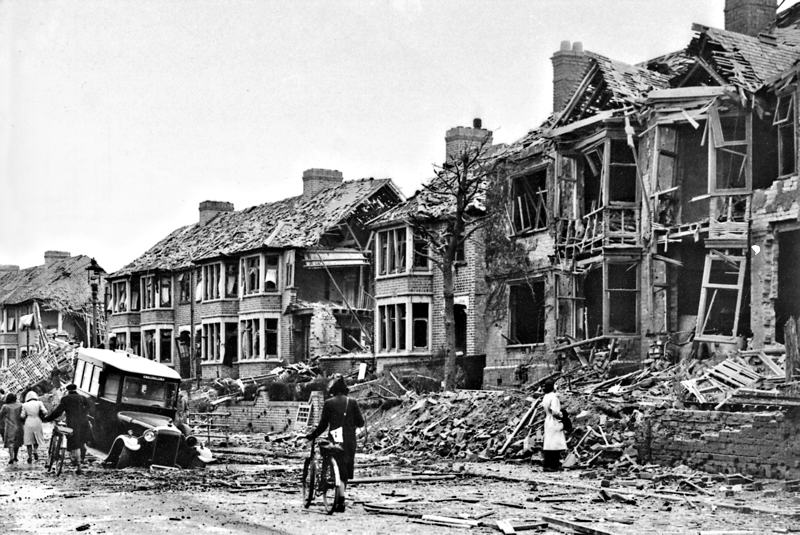
 n this particular evening us kids bedded down under our table, as was normal before the sirens sounded. The raids were now beginning later as daylight lengthened, and as they sounded came the instant choking, tightness of chest and throat, the short panting breaths and roaring ears, as I listened to hear the dreaded "whum-whuming" sound of the incoming aircraft engines - said to be a psychological terror tactic to instil fear at the sound of their approach. I have no doubt it worked on me, as when the sirens sounded I was terrified what might or might not happen, but never knew until they either flew over on their way on to Birmingham and beyond, or started on us immediately. Whatever they did would be unpredictable and the wait nerve-racking.
n this particular evening us kids bedded down under our table, as was normal before the sirens sounded. The raids were now beginning later as daylight lengthened, and as they sounded came the instant choking, tightness of chest and throat, the short panting breaths and roaring ears, as I listened to hear the dreaded "whum-whuming" sound of the incoming aircraft engines - said to be a psychological terror tactic to instil fear at the sound of their approach. I have no doubt it worked on me, as when the sirens sounded I was terrified what might or might not happen, but never knew until they either flew over on their way on to Birmingham and beyond, or started on us immediately. Whatever they did would be unpredictable and the wait nerve-racking.
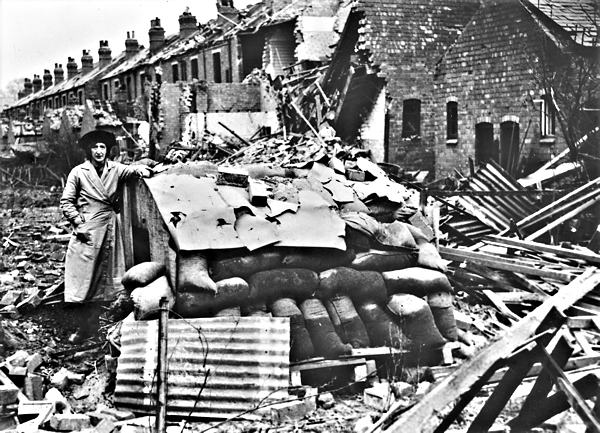
That is how it happened the previous evening. We'd had an all night session and now they were back, and it now seemed even heavier already. At about 9:30 p.m. Dad had loaded up the toe-room and boot of the sidecar of his motor cycle with spare blankets and clothes, with Mum and Brother in the sidecar and me clinging behind Dad on the pillion as we went off up the Tamworth Road and turned into Long Lane. About 500 yards down we turned into a field under some Oaks or Elms and stopped, facing towards the city. In all the raids we were subjected to until that day, this was the first time I had been outside during a raid, being always in complete darkness or, at most, a single candle. The flashes of the explosions was never visible to us - sound was all I had ever known until now. What I saw now looking from left to right was a 210 degree panorama of extra bright, pinkish-red moonlight, and I could almost see our house but for the trees around St. Thomas' Church in the diffused pink haze. Directly to our front were two descending red coloured flares and a third to the right - each a cluster of seven or eight intensely burning red coloured balls, as if on an invisible Christmas tree - each ball trailing a fine trail of white smoke. As I watched, a fourth flare seemed to pop into burning red balls, one after the other, making a line of four staggered flares across our front view.
Suddenly, as we sat, to our right came a sound like "sssssssshwwa" as a shower of shrapnel peppered down into the tree-tops, and that was what made Dad decide to take us out to a small village called Eathorpe, where we had been offered shelter on a farm if ever things got too bad. Being out along the London Road to Princethorpe to the turnoff, we first went back past home down Radford Road to get to my gran in Hillfields, to see if she was safe, but were stopped in the hollow down from the Savoy Cinema by ARP Wardens. They redirected us left past Courtaulds, but we seemed to run into an area already in trouble as we passed fires burning, rubble on the roads, fire hoses, and tenders blocking this way and that. Dad was up and down on and along pavements to miss hoses crossing and blocking our way. It took us a scary long time in my mind to get to Hillfields, clinging to Dad for dear life, scared to death at what I would see if I opened my eyes as we bumped and bounced around the streets in the pink moonlight.
Finally we got to Canterbury Street and parked outside number 13 - where I was born almost almost exactly eight years before, in April 1932. Dad went to look for gran who was, in fact, taking refuge and safe in St. Peter's Church crypt across from where we were waiting. All the time the whistles and whooshes of falling bombs and explosions in all directions near and far sounded completely different to the more muffled sounds I'd heard from under our kitchen table. Once Dad returned we set off into similar conditions - roads closed this way and that, rubble all over - and finally we got to the London Road via Gulson Road. Everywhere was still bathed in the pink half-light, and I remember it being particularly bright when we came to Ryton on Dunsmore. It was extra bright so maybe there was a flare immediately above at the time but I didn't notice.
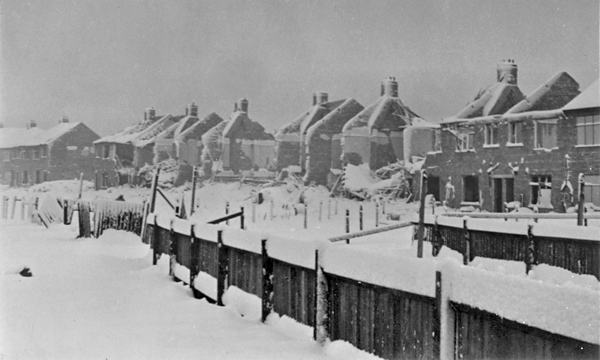
By now I was very cold in pyjamas and gown. My legs were warmed by the engine but I was freezing. From there, as we passed the Rootes Factory, I remember the name in a contrasting colour spelt down the stack being partially obscured from the road, I think by trees or perhaps smoke as we passed, the red pinkish haze by now fading to darkness as we moved farther out. Away from the city progress was even slower as the masked headlights with the required slatted visors were not of much use for lighting the dark road ahead. Arriving at the farm after 1 a.m. we bedded on top of sacks of shelled small, red peanuts used for a cattle food supplement, being a dairy farm. The rumblings from Coventry were now more like a distant thunder, sleep was short lived with the clatter of buckets and a diesel engine starting up about 4:30 a.m. as they began the day's milking session. Later that day we moved over to a less noisy barn overnight, as we were to return to Keresley the next day. On our return journey home we were prevented from using the London Road into town at Ryton on Dunsmore, and very interesting for a small boy like me, were diverted down lanes and passed an Airfield very close to the road where there were Hurricanes, and one was parked, wheels down, in a flying attitude, as if he had tried to land on top of the hedge. His wing wheel was down on our side, the low hedge neatly showing a gap between the belly as his tail wheel was braced up off the hedge, all neatly out of the way as if lifted there by a crane.
The traffic was kept on the move and is what I observed as we passed at the time. Why traffic was diverted I never knew, and I wondered why, as Dad had returned to Eathorpe to pick us up the previous evening and came directly through town onto the London Road with no problem. From there I've no idea where we were until we got to Holyhead Road, and called in near the Alvis to an aunt in Sussex Road to see if they were safe, then on past a crater being filled in in the street outside a damaged house in Radford, and home to sleep again back under my table air-raid shelter once more that evening.
Read Jerry's pre-war memories of Hillfields.
Website by Rob Orland © 2002 to 2025